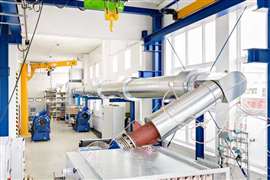Read this article in 中文 Français Deutsch Italiano Português Español
Chevron, Solar Turbines working on hydrogen
March 14, 2023
Collaboration seen as ‘promising opportunity’
 Solar Turbines is working with Chevron on a turbine engine partially fueled by hydrogen. (Image: Chevron)
Solar Turbines is working with Chevron on a turbine engine partially fueled by hydrogen. (Image: Chevron)
Chevron and Solar Turbines said they are working together to adapt a low-emissions turbine engine partially fueled by hydrogen.
Blending hydrogen with traditional fuels to power the engine could help reduce its greenhouse gas emissions, and the results from the collaboration could inform the potential of lower carbon turbine intensity operations in the future, the companies said.
“We believe this collaboration offers a promising opportunity to further develop hydrogen for commercial gas turbine applications,” said Stuart Quay, Solar Turbines’ manager of strategic growth. “Solar’s commitment to provide reliable power solutions while lowering greenhouse gas emissions makes us a good fit to work with Chevron on this project.”
While conventional combustion turbines have been capable of running on high hydrogen blends for many years, this new collaboration will work to increase the level of hydrogen used in low-emissions turbines, the companies said.
The tests will take place in California where Chevron uses natural gas turbine engines in oil and gas production operations, including to generate steam for enhanced oil recovery applications.
Solar Turbines has been running its gas turbines with hydrogen since the 1980s. This demonstration will be the first time that the company will test with such large volumes of hydrogen in a low-emissions turbine.
“We are using our existing assets to provide a test bed so that Solar Turbines can qualify their equipment for higher blends of hydrogen,” said Ben Leonard, Chevron hydrogen product owner.
Solar Turbines will be looking to retrofit existing turbine equipment that its customers already own.
Elizabeth Vose, Chevron hydrogen commercial advisor, said one of the goals of this project is to run a turbine engine at a blend of 50% hydrogen and 50% natural gas.
The initial tests by Solar Turbines will blend between 20% and 50% hydrogen with natural gas.
“Going directly from natural gas to 100% hydrogen with low-emissions combustion systems is challenging,” Leonard said. “The vision is to blend hydrogen with natural gas on a large scale. This allows the industry to make equipment changes and be ready for the transition to an emerging hydrogen future, the goal being to drive down the carbon intensity of existing operations.”
MAGAZINE
NEWSLETTER

CONNECT WITH THE TEAM









